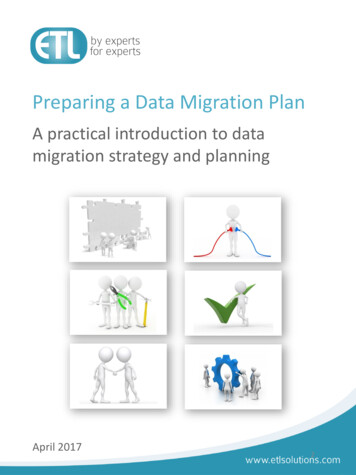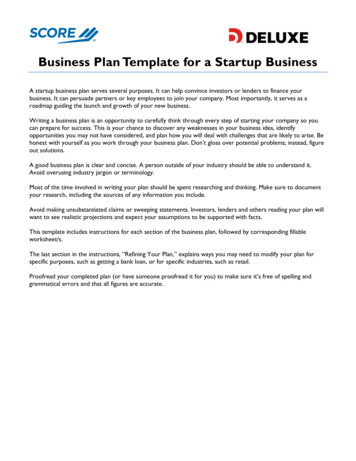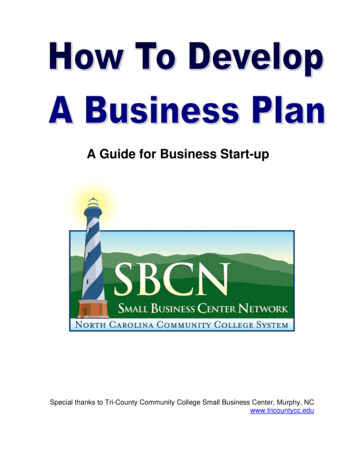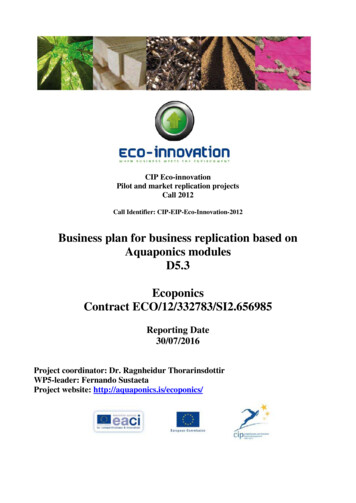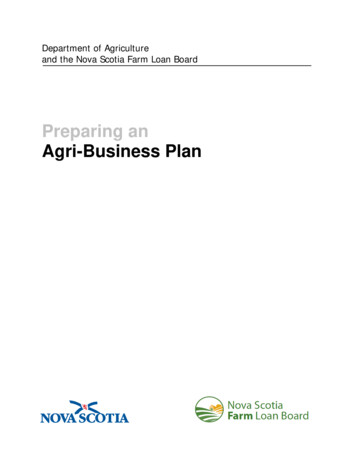
Transcription
Department of Agricultureand the Nova Scotia Farm Loan BoardPreparing anAgri-Business Plan
TABLE OF CONTENTSTHE BUSINESS OVERVIEW1MARKETING PLAN9HUMAN RESOURCES PLAN15PRODUCTION PLAN20FINANCIAL PLAN23GLOSSARY OF BUSINESS FINANCE TERMS31
Preparing anAgri-Business PlanPlanning for ProfitThe Business OverviewIntroductionWhy do you need a business plan?A business plan allows you to create a business operation on paper andmanipulate and evaluate scenarios without the risk of investing a lot oftime and money. Dry run planning reduces the possibility of the venturefailing, by identifying your proposals, strengths and weaknesses, anddeveloping a plan of action to cope with them.Financial institutions, business partners, and investors will all require thatyou have a proper business plan to prove your ideas are viable and thatyou have adequate knowledge of your chosen area of business.Whether you are starting a new business, buying an existing one, orexpanding your present operation, a business plan will help you preparefor the unexpected and help set the goals for your future businesssuccess. There is no replacement for a well thought out business plan.Be realistic in your projections, honest in your evaluations, and thoroughin your research.Why do you want to operate an agri-business?An overwhelming fondness for plants, animals and nature is not asufficient reason to want to own and operate an agri-business.In business, your primary goalis to make your company aprofit so it will be able tosurvive and prosper.Department of Agriculture Nova Scotia Farm Loan BoardPage1
Getting started in an agri-business will require thefollowing:Î Generalknowledge of the agriculture industry.Î Recognitionof your business opportunity or advantage.ÎAmarket for your product and a thorough understanding of thatmarket.Î Technicalknowledge of crop production practices and/or livestockproduction.Î FinancialÎ Theresources to develop your operation.necessary business management skills.Where do I get the information to prepare my businessplan?To prepare a plan, you need to research your proposed business. Thefollowing sources of information will be helpful in developing your plan:Î InterviewsÎ ExtensionWith Other ProducersSpecialistsÎ PersonalWork ExperienceÎ IndustryConsultantsÎ LibraryResearchÎ TradeSuppliersÎ TradeMagazines and JournalsÎ DemographicÎ IndustryStudiesAssociationsÎ NewspaperArticles, etc.Remember a plan is just a plan and must be continually adjusted to thechanging conditions of your business. If something is not working, adaptit until it works.Business Advisors (Informal Board of Directors):These are people with specific areas of expertise useful to your business.All business managers can take advantage of the resources and expertiseother specialists have to offer. The cost of this expert advice is moderatewhen compared to the cost to your business of making uninformeddecisions. It has been well proven that a business will grow much fasterwith the help of an experienced group of advisors. Search out all theexpertise you require!Department of Agriculture Nova Scotia Farm Loan BoardPage2
Industry OverviewThe foundation of your business plan is your research or ground work.Every idea or concept should be challenged to determine whether or notit has a reasonable chance of success.An assessment of pertinent issues for theindustry will enable you to develop a morecredible plan.Consider these questions as you challenge your idea:1.(a) Are there global or international issues that will affect mybusiness?(b) Are there national or interprovincial issues that should befocused on?2.Are there regulations or restrictions that can positively ornegatively impact on my project?3.Identify major trends affecting the industry.Try to determine strengths, weaknesses, opportunities, and threats in theindustry that will impact on your agri-business.What is a Business Plan?A business plan is an effective management tool that outlines how youintend to run your business. As a management tool, a business plan willhelp you determine the goals you need to achieve in order to operateyour business successfully. Normally, a business plan is made up of thefollowing sections:9Business / Industry Overview9Production Plan9Market Plan9Financial Plan9Human Resources PlanEach individual plan (section) contributes to the resulting overall businessplan giving you a document to access the progress of your business.Department of Agriculture Nova Scotia Farm Loan BoardPage3
Business OverviewTitle PageThe title page immediately and clearly identifies the subject matter of thedocument for the reader. If the plan is being presented to a banker,accountant or other advisor, it will be less likely to be lost in the shuffle.The title page should specify the farm name, address, phone number,subject (Business Plan) and the date completed.Table of ContentsThe table of contents helps readers go directly to the information theywish to examine.It can be very frustrating to flip through largequantities of information which has no particular order. The table ofcontents helps provide structure and order to the business plan and helpsto make sure that the plan is thorough.Mission Statement The Business Vision "Mission involves a statement about the type of customerthe organization wishes to serve, the specific needs ofcustomers and the means or technology by which it willserve these needs."Berkowitz, Kerlin, Rudelius and Crane, 1991Goals then take the broad statement of mission and translate it intospecific and measurable objectives (goals).Business HistoryThe business history quickly outlines the origins and development of thebusiness. It helps identify where you are in the long term developmentof your business.Business Profile and SummaryThe business profile and summary is a condensed version of the businessplan. It provides the reader with a quick overview of the highlights ofthe business plan making the business plan easier to read and follow.The next section covers the Business Profile and Summary in greaterdetail.Business OrganizationWho are the investors in your business plan? How is managementdivided among participants in the business? How are profits divided?There are several possible forms of business organization or ownership.The most common in Nova Scotia are the proprietorship, partnership,limited company and co-operative. The major features of each are asfollows:Department of Agriculture Nova Scotia Farm Loan BoardPage4
Proprietorship a business operated and controlled by a single individual income of the business is treated as personal income for tax purposes legal or other liabilities arising from the operation of the business are thedirect responsibility of the individual least expensive form of organization.Partnership formed when two or more individuals carry on business together andagree to share profits and losses of the business jointly income for tax purposes is allocated to the individuals on the basis oftheir agreement partners are jointly responsible for debts and other liabilities highly advisable to have a written partnership agreement whichestablishes the details of the relationship, especially responsibilities,control, division of income (or losses), and procedures for amending orterminating the agreement.Limited Company separate sets,and a legal procedure which requires filing a constitutional document TheArticles of Incorporation, the selection of a board of directors and oftenthe drafting of a Shareholders Agreement can be set up under either federal or provincial law with a typical cost inthe range of 800 to 2,000 an incorporated company can provide some financial advantages throughshare ownership and special rules for taxation which apply tocorporations and small businesses may be a requirementassistance erative an organization incorporated provincially under the Co-operatives Act can involve any type of business financed by the purchase of shares by members who receive a vote onthe operation of the co-operative and a limited return on their shares profits are returned to members in proportion to the use the membermakes of the co-operative (products or services sold or purchased).Department of Agriculture Nova Scotia Farm Loan BoardPage5
There are also other forms of organization including limited partnerships,associations or societies.The suitability of each depends on yoursituation. Discuss your own particular needs with your professionaladvisors before making a decision.Business Profile and SummaryThe business profile and summary gives the reader an abstract view ofthe business plan and determines whether the document is worth furtherconsideration. It is usually the first section read and the last prepared.It should be concise and to the point.Purpose:Describe what business you are in, why you are in it,what size it will be, and how you will sell yourproduct.Example:This plan will outline our proposal to operate a 5,000sq./ft. greenhouse operation and make a profitproducing and selling bedding plants retail to thegeneral public in Planttown, Nova Scotia.Please Note:The examples throughout the agri-business planning guide followthis greenhouse operation. The plan can be modified for everyagricultural commodity.Financing RequirementsExample:To establish and operate the proposed greenhouseoperation, the following financing will be required.(Please note that the numbers used are for examplepurposes only and may not reflect true marketvalues).9 100,000.00 in total to establish and operate thebusiness.9 20,000.00 for land.9 50,000.00 for buildings and improvements.9 30,000.00 for operating capital.9 50,000.00 will be equity capital by owners.9 50,000.00 will be required as borrowed capital.Department of Agriculture Nova Scotia Farm Loan BoardPage6
What investment is required to start this business operation?Financial Guidelines: Debt repayment will be structured to minimizecash flow strain in the early years. A target of 60% equity is to beachieved within 4 years and maintained at 50% or greater throughout allfuture expansions. Finally, a target of zero operating credit requirementsis set for the 5th year of operation with all short term credit requirementsbeing supplied from the business operations.MarketingWho are your target customers and what is your potential market?Example:To develop a reputation as a supplier of qualityhanging baskets and bedding plants and toeffectively penetrate the market in the 1st year ofoperation by offering products not supplied by othergrowers in the area. The goal is to expand themarketplace by expanding the variety of productsavailable to the gardening public. Sales of beddingplants will extend within a market radius of 20kilometers and populations of 20,000 with a total of25,000 sq. ft. of greenhouse space supplying thismarket. A target of 20% of the business is expectedto be sales to landscaping firms with the 80%balance as retail sales to private residents and localbusiness.ProductionWhat are production targets and how will those targets be achieved?Example:We will maintain maximum production and optimalyields of crop production through close monitoring ofthe greenhouse crops. Production schedules will befollowed closely constantly striving for improvementsin our production practices. Using the past 1 yearexperience in a well recognized greenhouseoperation, continuing education courses in beddingplant production, as well as the specialized study ofhanging baskets and bedding plants will allow us toproduce the maximum output for the greenhousespace we have available. Double cropping wherepossible. Targeting 1,000 hanging baskets and 2,000flats of bedding plants.LabourWhat labour requirements will your business have and how will yousatisfy those needs?Department of Agriculture Nova Scotia Farm Loan BoardPage7
Example:In the beginning, all labour will be supplied by theowner operator and family members. It is expectedthat by the 2nd year some staff will have to be hired.In anticipation of this, we have developed a companyemployment policy booklet as well as job descriptionsfor the various positions. We intend to maintain asafe working environment for our staff and to followthe Department of Labour guidelines. We will useflex time and innovative labour management ideas tobest motivate our employees.ConclusionA business plan is the written guide to your business's success. You canhave others prepare your business plan, but you really should be the onedeveloping the plan using others only for assistance. The plan reflectsyour image and views of your business. The process of developing theplan may be much more valuable as a learning experience than the planitself. When completed, you should have your plan reviewed by someoneobjective but knowledgeable in your business operations.Business Overview is the first in a series of five sections that will helpyou prepare a business plan for your proposed agri-business operation. Department of Agriculture 1.Business Overview2.Marketing Plan3.Human ResourcesPlan4.Production Plan5.Financial PlanNova Scotia Farm Loan BoardPage8
Preparing anAgri-Business PlanPlanning for ProfitMarketing PlanIntroductionA major aspect of any business plan is the section dealing withmarketing. Marketing is the process of understanding the customer’sneeds, producing a product to meet those particular needs, and making aprofit for the business. If you are planning to start a new business orexpand an existing one, it is essential to prepare a "marketing strategy" .Your target market must be well defined before any action is taken onproduction. There is little sense in going through the steps of producinga product only to find out after the fact that there is a limited or nomarket for that product or service.Know Your Customer!Know Your Market!Since it is very diffi
A business plan allows you to create a business operation on paper and manipulate and evaluate scenarios without the risk of investing a lot of time and money. Dry run planning reduces the possibility of the venture failing, by identifying your proposals, strengths and weaknesses, and developing a plan of action to cope with them. Financial institutions, business partners, and investors will .






